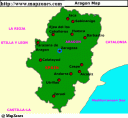OK, maybe it is just geographically challenged Wine Tasting Guy who doesn’t know where Aragon is. But I found out today. It is in Spain. And I was lucky to be able to attend a tasting of Aragon wines at the NY Metropolitan Pavilion.
A varietal that was planted in abundance at one point is Carignan, (AKA Carignana), which got its name from the subregion on Aragon “Carignena”. A great page about wines of Aragon can be found here. Also of note, as long as we are discussing Carignan, is that it is the most widely planted grape in France today (according to winepros.org – bet you didn’t know that – I sure didn’t).
The tasting itself was very nice. The tasting booklets were done on typical 8 1/2 X 11 sheets and stapled together, so nothing fancy there (hey, not everyone has the budget), but the location was great, the people pouring were very cordial, it was not too crowded and there were only 6 tables pouring wine (and two tasting olive oil – I told you it WAS IN).
I tasted 28 wines of which 4 were dry whites, 2 were Rose’s, 1 was a sweet dessert white (the only one I swallowed as I had it last but it was not really worth it) and the rest (21) were reds.
Of the 4 whites, 1 was a Chardonnay, 2 were blends (both were 80% “Macabeo” [AKA Viora & often used in Spanish sparkling wine or “CAVA”] & 20% Chardonnay) and the 4th was a beautiful bone dry Muscat. The Chardonnay, the 2007 Aragus Campo de Borja was unoaked and had a very lite yellow/straw color. Citrus aromas with some stone fruit & floral tones led to a crisp palate of bitter grapefruit and creeping acidity with a clean finish. The blended whites were crisp but very nondescript. I am not sure if that is an indictment on all Macabeo (which i was told is a very mild grape) but these seemed almost bland. Finally, the Muscat, the 2007 Carinus Blanco Muscat (Carinena). A very pretty and sweet smelling wine with a lite yellow/lemon color. Aromas of melon, apple and fresh flowers led to a bone dry but very fruity and crisp palate. This wine will go well with many summer meals out on the porch.
The reds were mostly blends, with Garnacha (grenache) the most popular varietal used. Also used in the wines/blends was Tempranillo, Carignan, Cabernet, Merlot, Syrah and Tinta del Pais (which I learned is really just another name for Tempranillo). In general a lot of the wines are made without any oak aging and were consequently young (in color, smell and taste) and aggressively priced (under $10/bottle). There were some Crianzas and Reservas that did see some oak aging and I found them to be more distinguished and to have better structure. The 2006 Vina Alarba Red, made with 60% Grenache and 40% Syrah saw no oak aging and showed very nice pure fruit. It isn’t a wine to be cellared, but its forest berries and nice structure made it a very nice quaffer, especially at $9 a bottle.
Of distinction among the reds was the “Marques de Tosos Reserva 2004 (Cainena) made with 40% each grenache & tempranillo & 20% cabernet. It had nicely integrated elements of oak, earth, leather and mild fruit. A well structured wine with a nice medium + finish. The “8.0.1 Selection Especial” (Carinena) was a non-traditional blend of 1/3 each Cabernet, Merlot & Syrah that showed forest fruit & forest floor on the nose, with a modest fruit palate, gripping tannins, and a nice finish. The “Senorio del Aguila Reserva” 2002 (Carinena) was showing its age with its brick orange color. It had some nice earth, tar and leather elements and reminded me of a Rioja with its potent acidity. And finally, the “vina Alarba Pago San Miguel” 2004 (Calatayud) made of 70% grenache & 30% cabernet showed nice red &black fruit on the nose and palate and was well structured, had pure fruit and was an overall very pleasant wine.
Time for sleep. But definitely check out an Aragon wine if you are presented with the opportunity.
Happy Spanish wine tasting and HAPPY 4TH OF JULY!!!!!
WTG

Wow, I’ve never heard of Aragon and I’ve spent a lot of time in Spain. What a great opportunity to indulge in.